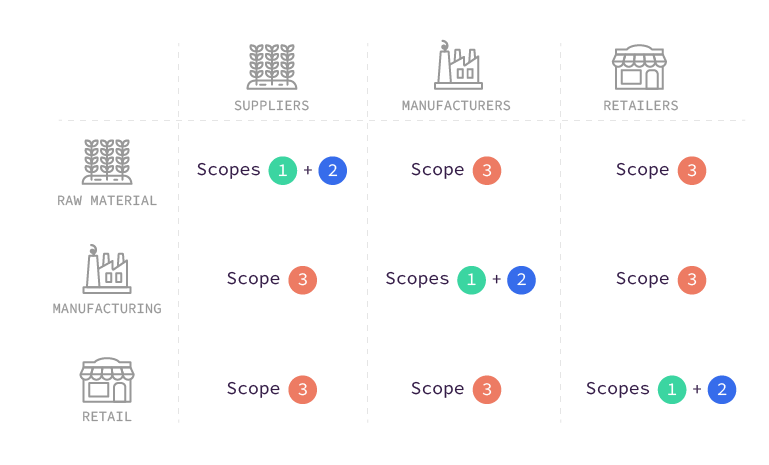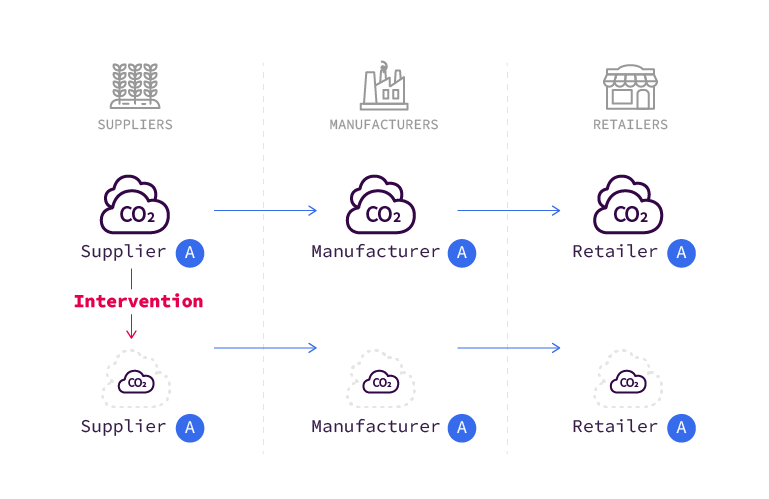02
Is it cheating if your company takes credit for an emissions reduction that another company accounts for in their own inventory?
Not necessarily. As Quantis Global Director of Solutions and Innovation Jon Dettling notes: “There is a legitimate opportunity for multiple companies to count the same reduction or removal in their scope 3 if managed the right way.”
For some emissions, such as scope 3, double counting is almost impossible to avoid because another company will inevitably count those emissions as their scope 1 emissions.
This also happens in the world of finance, where transactions can be counted more than once. For example, the cost of intermediate goods used to produce a finished product is included in both a company’s reporting and in a nation’s gross domestic product calculation.
That said, some types of double counting can put your reputation at risk by undermining the environmental integrity and credibility of your company’s activities and reporting. In this chapter, we’ll delve deeper into the topic of double counting, paying close attention to when double counting is acceptable and when it’s not. While several different examples of double counting will be covered, they don’t represent the entire spectrum of possibilities.
Read all recommendations
Double counting is a normal part of scope 3 emissions accounting. Whether it is problematic depends on how the reported information is used. Here, we’ll look at the key differences between shared accountability (acceptable double counting sometimes referred to as co-claiming) and unacceptable double counting.
For example, a retailer would account for emissions at its store as scope 1 and 2 and then everything else (extracting raw materials, transforming the raw materials into a finished product, etc.) would count as scope 3. These same scope 3 emissions would be scope 1 and 2 emissions for the raw materials producers or product manufacturers in the retailer’s value chain.

Rigorously following standards and being clear about what is counted for each scope is vital to provide clarity to stakeholders about what emissions are included in which scope and why.
This also applies to the target level. If one company’s target is to reduce direct emissions from generating its product and another company has a target to reduce indirect emissions from buying that product, they will mutually benefit from one another’s reductions. For example, if a supplier reduces its emissions, both the processor and the retailer will be able to claim that their scope 3 emissions have decreased if the supplier’s reduction is kept in that value chain.

This overlapping of targets presents an opportunity to foster collaboration across the value chain that will ultimately accelerate emissions reductions.
Double counting in this instance refers to the shared responsibility of companies and nations to reduce emissions. This situation could arise if a national government decides to promote green energies over coal. Companies operating in this country would benefit from improved access to (or funding for) green energies and would be able to focus their emissions reductions efforts in countries where there is weaker (or a lack of) government climate action .
Emissions reductions or removals resulting from interventions by any entity within a supply chain can be sold as a carbon credit to a voluntary carbon market. If a company (or one of their suppliers) is intentionally selling credits to the voluntary carbon market, it is advised to not double count the emission reduction or removal in a corporate inventory and thus to adjust the inventory in relation to the credits. The reason for this is that other companies can buy the credits from the voluntary carbon market and use them as a uniquely claimed emission reduction or removal that they use to offset or compensate their emissions. Thus there is a double count of the emission reduction or removal if the credit is used as an offset and the seller of the credit does not adjust their inventory for what they sold.
There are also emerging ways credits can be sold and used that are not as “offsets” and thus carry different and potentially lower double counting risks. This could be for example when credits are sold to fulfill a quota or to make financial claims. In the case that credits are sold and there is transparency on their use (not as an offset), it is less of a double counting risk to also account for the emission reduction and removal within a corporate inventory. As an example, if a company wants to claim a certain financial contribution to nature based solutions and is otherwise on track for their science based targets (SBTs), and thereby buys credits from another company who enacts nature based solutions within their supply chain, the company doing the action has less risk that they double count if they follow normal accounting rules to report their inventory without adjustment.
Further, large multinational companies have a risk that credits are being generated and sold as the choice of any given entity within their value chain. In order to avoid this risk, which could lead to unintentional and largely unidentifiable double counting in the multinational’s inventory, it is recommended that multinationals work on value chain traceability and ways to encourage within value chain action such that there is incentive to keep claims in relation to climate action within the value chain.

A supplier cannot allocate reduced emissions from a given amount of a “low-emission” product or service to more than one customer at a time. Let’s say a cocoa supplier has implemented an intervention in agreement with one of its customers, cocoa manufacturer A, for the amount of products they purchase. Cocoa manufacturer A is the only manufacturer that will be able to account for this reduction in its inventory, which can then be transferred to its own customer, retailer A. If both cocoa manufacturer A and retailer A can claim these reductions, they cannot be claimed by the cocoa supplier’s other customers, manufacturer B and retailer B, even if they also purchase cocoa from that supplier. They will have to claim the full impact of the product they purchase from the supplier.

To allocate the reduction to its customer after carrying out an intervention, the supplier must follow robust and transparent allocation rules. There are two ways to do this:
In both cases, we recommend following a contractual agreement and a proper accounting system at the supplier level to track the amount of improved commodities over a specified timeframe to avoid double counting. To prevent a customer that isn’t authorized to claim a reduction from doing so, suppliers should report emissions factors for improved and unimproved commodities separately. Doing so allows companies that can’t claim the reduction, or can only claim a partial reduction, to use the appropriate emissions factor to avoid double counting improvements already claimed by an industry peer.
Collaborate on interventions, measuring and assigning reductions.
When value chain partners work collectively with their suppliers to implement value chain interventions, everyone wins. Keeping the activity within the value chain, rather than selling carbon credits to external organizations, allows you to focus resources on reductions as well as help others in your value chain reach their targets. Suppliers should establish emissions factors for improved and unimproved commodities and report them separately to their customers to ensure that companies unable to claim a reduction will use the correct emissions factors.
Don’t claim reductions without doing adequate due diligence to ensure that they’re not already being claimed by another similar actor or value chain.
For both credibility and progress tracking purposes, it’s critical to know where emissions reductions took place and whether an actor at a similar stage of the value chain already claimed them. If buyers know that certain credits are part of a scope 3 intervention and that another company is buying all of them- as offsets, they shouldn’t claim them as reductions. By the same token, suppliers shouldn’t sell offsets for emissions reductions reported in their own scope 3 inventory nor enable two of their customers to account for the same reductions. As more and more targets don’t allow the use of offsets, the natural place for companies to look for reductions is in their own value chain.
Develop a policy for shared accountability and double counting and communicate it with key stakeholders.
This policy should be communicated internally and must clearly set forth how to reconcile reductions related to other programs. It should also outline which types of double counting are (or are not) considered and why, and situations where double counting may arise, particularly in relation to scope 3 reductions, to limit the likelihood of misinterpretation, to build confidence for future claims and to increase transparency.
We have answers. Get in touch with our team today and let us guide you through the solutions that might help you on your journey toward a sustainable supply chain.
01
This chapter covers what is considered real progress toward sustainability as you calculate and track changes in your supply chain.
Read
02 – Currently reading
This chapter focuses on how to manage the double counting of emissions reductions when considering real progress toward a sustainable supply chain.
Read
03
This chapter covers why understanding the concept of supply sheds can help make more active progress and ensure companies will be able to claim progress.
Read
04
Progress toward a sustainable supply chain hinges on the type of data one is using and why. Here we’ll differentiate the types of data and guide you to choose what’s right for your goals.
Read
05
This chapter dives deep into tools that rely on primary data and their implications for tracking progress in the supply chain.
Read
06
Progress toward a more sustainable supply chain is possible even with a fair amount of uncertainty. This chapter covers how to measure and manage uncertainty.
Read
Quantis partners with leading consumer goods and financial services organizations to drive sustainable transformation to operate within planetary boundaries.
We balance the latest science with business acumen to guide our clients to future-proof their business and thrive in a new planetary economy. We believe in the power of business to create a sustainable future where nature, people – and business – can thrive.
Get in touch with our team today and let us guide you through the solutions that might help you on your journey toward a sustainable supply chain.
We’ll use your data fairly, transparently and exactly as you want us to in compliance with GDPR. For all the details, read our Privacy Portal.
You have 50% of the chapter left to read. Please share your email to continue the reading.
By submitting, you consent to allow Quantis to share sustainability-related content.
You can unsubscribe at any time. For more information, please review our Privacy Policy.
I’d rather not. Please take me home.